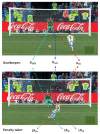Body Pose Estimation Integrated With Notational Analysis: A New Approach to Analyze Penalty Kicks Strategy in Elite Football
- PMID: 35368420
- PMCID: PMC8964455
- DOI: 10.3389/fspor.2022.818556
Body Pose Estimation Integrated With Notational Analysis: A New Approach to Analyze Penalty Kicks Strategy in Elite Football
Abstract
Body orientation of football players has proven to be an informative resource related to successful penalty kicks. OpenPose is one of the most popular open-source pose estimation technologies. This study aims: (i) to verify whether OpenPose can detect relevant body orientation angles from video data of penalty kicks in elite football and (ii) to investigate the relationship between these body angles and observable behaviors analyzed via an observational system for penalty kick analysis in football (OSPAF) with the penalty taker and goalkeeper strategy. A total of 34 penalty videos, with standardized viewing angle, from the main European leagues (2017-2020) were analyzed. Relevant body orientation variables were selected for penalty kicks analysis and were extracted from video data through OpenPose technique. The OSPAF, previously validated by experts, was used. The mean confidence score of OpenPose measures was 0.80 ± 0.14. OpenPose Retest reliability values was 0.976 ± 0.03. Logistic regressions were performed to investigate the relationship between OpenPose investigated variables (penalty taker: shoulder, hips, and nonkicking foot orientation; goalkeeper: right and left foot, anticipation), observable behaviors (OSPAF variables), and the strategy (penalty taker: goalkeeper dependent or independent; goalkeeper: shooter dependent or independent) in penalty kicks. The selected body orientation angle (goalkeeper anticipation) measured through OpenPose correlated significantly with the goalkeeper strategy. The prediction model of the goalkeeper's strategy had its accuracy increased to 97% when the variable goalkeeper anticipation was included [ = 49.648, p < 0.001]. Lower degrees of goalkeeper anticipation, the goalkeeper tactical action (awaiting), and run up speed (slow) were associated with a kicker-dependent strategy. Regarding the penalty taker, the selected body angles measured through OpenPose did not associate significantly with the shooter strategy. Body orientation analysis by using OpenPose has shown sufficient reliability and provides practical applications for analyzing the strategies adopted by goalkeepers in penalty kicks in elite football.
Keywords: OSPAF; OpenPose; body orientation; human movement; motion capture; performance analysis; soccer analytics.
Copyright © 2022 Pinheiro, Jin, Costa and Lames.
Conflict of interest statement
The authors declare that the research was conducted in the absence of any commercial or financial relationships that could be construed as a potential conflict of interest.
Figures


Similar articles
-
Design and Validation of an Observational System for Penalty Kick Analysis in Football (OSPAF).Front Psychol. 2021 May 28;12:661179. doi: 10.3389/fpsyg.2021.661179. eCollection 2021. Front Psychol. 2021. PMID: 34122246 Free PMC article.
-
The mere presence of a goalkeeper affects the accuracy of penalty kicks.J Sports Sci. 2013;31(9):921-9. doi: 10.1080/02640414.2012.762602. Epub 2013 Jan 29. J Sports Sci. 2013. PMID: 23360203
-
Case Report: Effect of providing penalty kicking tendencies on goalkeeper's motor behaviour and performance: a case study with an on-field intervention on youth football.Front Sports Act Living. 2024 Sep 12;6:1356340. doi: 10.3389/fspor.2024.1356340. eCollection 2024. Front Sports Act Living. 2024. PMID: 39329051 Free PMC article.
-
Match analysis and the physiological demands of Australian football.Sports Med. 2010 Apr 1;40(4):347-60. doi: 10.2165/11531400-000000000-00000. Sports Med. 2010. PMID: 20364877 Review.
-
The effectiveness of penalty takers' deception: A scoping review.Hum Mov Sci. 2023 Aug;90:103122. doi: 10.1016/j.humov.2023.103122. Epub 2023 Jun 28. Hum Mov Sci. 2023. PMID: 37390769
Cited by
-
Sarcopenia classification model for musculoskeletal patients using smart insole and artificial intelligence gait analysis.J Cachexia Sarcopenia Muscle. 2023 Dec;14(6):2793-2803. doi: 10.1002/jcsm.13356. Epub 2023 Oct 26. J Cachexia Sarcopenia Muscle. 2023. PMID: 37884824 Free PMC article.
-
Sarcopenia diagnosis using skeleton-based gait sequence and foot-pressure image datasets.Front Public Health. 2024 Nov 27;12:1443188. doi: 10.3389/fpubh.2024.1443188. eCollection 2024. Front Public Health. 2024. PMID: 39664552 Free PMC article.
-
Measurement Properties of Wearable Kinematic-Based Data Collection Systems to Evaluate Ball Kicking in Soccer: A Systematic Review with Evidence Gap Map.Sensors (Basel). 2024 Dec 11;24(24):7912. doi: 10.3390/s24247912. Sensors (Basel). 2024. PMID: 39771651 Free PMC article.
References
-
- Almeida C. H., Volossovitch A., Duarte R. (2016). Penalty kick outcomes in UEFA club competitions (2010–2015): the roles of situational, individual and performance factors. Int. J. Perform. Anal. Sport. 16, 508–522. 10.1080/24748668.2016.11868905 - DOI
-
- Altman D. G. (1991). Practical Statistics for Medical Research. Boca Raton, FL: CRC Press.
-
- Cao Z., Simon T., Wei S., Sheikh Y. (2017). Realtime multi-person 2D pose estimation using part affinity fields, in IEEE Conference on Computer Vision and Pattern Recognition (CVPR), (Honolulu, HI: IEEE; ), 1302–1310. 10.1109/CVPR.2017.143 - DOI
LinkOut - more resources
Full Text Sources

